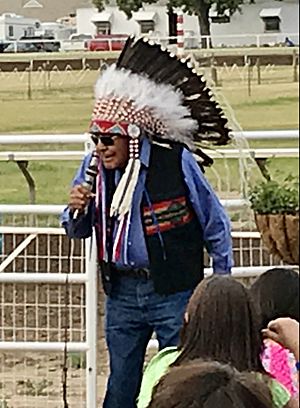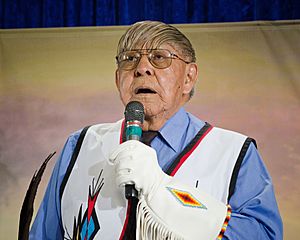Earl Old Person facts for kids
Earl Old Person (whose Blackfeet names were Stu Sapoo, meaning "Cold Wind," and Ahka Pa Ka Pee, meaning "Charging Home") was a very important Native American leader. He was the honorary lifetime chief of the Blackfeet Nation (Amskapi’Piikáni) in Montana, United States. He was born on April 13, 1929, and passed away on October 13, 2021.
Contents
Earl Old Person: A Blackfeet Leader
Early Life and Growing Up
Earl Old Person was born on April 13, 1929, on his family's land near Starr School, Montana. This area is part of the Blackfeet Indian Reservation. He was a full-blooded member of the Blackfeet tribe. His parents, Juniper and Molly Old Person, raised him and his many brothers and sisters.
He went to elementary school in Starr School and graduated from Browning High School in 1947. Earl always said his parents taught him to work hard and do well in school. He grew up learning the traditional ways of his people. The Blackfoot language was his first language, and he only learned English when he started elementary school.
Earl remembered many traditional Blackfeet stories, songs, and dances. This helped keep the Blackfeet culture alive for future generations. People said he had a special gift for remembering Indian music after hearing it just once.
His parents would greet their children every day with words meaning "good morning, get up, try hard!" His childhood home didn't have modern heating or indoor plumbing. But he grew up experiencing the horse culture of the Blackfeet people. He spent a lot of time riding horses, often without a saddle.
Earl was a talented musician and dancer. When he was only seven, he performed at halftime for the Browning High School basketball team. At age nine, he traveled to Cleveland and New York City for six weeks. He performed traditional Blackfeet songs and dances to help raise money for a new church on the reservation.
As a teenager, he played basketball for Browning High School. He kept his long braids even when coaches and other players tried to make him cut them. He just found it fun! A special moment for him was a trip to Moisson, France, in 1947. He attended the 6th World Scout Jamboree and was the only Native American there among over 24,000 participants. He even brought his father's tepee to set up as his camp.
Becoming a Leader
In 1950, Earl Old Person started working for the tribe's land office. One of his jobs was to help Blackfeet people who didn't speak English. At that time, the U.S. government had a plan called "termination." This plan aimed to end the special relationship between tribes and the government.
Earl Old Person spoke strongly against this plan in 1960. He explained that in his language, "termination" meant "to wipe out" or "kill off." He said it was like trying to cook a meal while someone was trying to burn down your house.
Tribal elders encouraged Earl to get involved in politics. In 1954, he was elected to the Blackfeet Tribal Business Council. He was the youngest person ever elected to this group. He became tribal chairman for the first time in 1964. He served as chairman for many years, becoming the longest-serving elected tribal official in America. He stayed on the tribal council until he retired in 2016.
In July 1978, Earl Old Person was given the special title of honorary lifetime Chief of the Blackfeet Nation. He considered this the greatest honor he ever received. This title was formally given to him by the family of James White Calf, whose father, White Calf, was the last principal chief of the Blackfeet Nation. Earl was also honored by the Kainai Nation in Canada, who made him an honorary chief for his work helping Indigenous people in North America.
Important Work and Achievements
Chief Old Person worked hard to protect the rights and culture of Native Americans. He supported laws like the American Indian Religious Freedom Act of 1978. This law helped protect Native American sacred sites and their right to practice their traditional religions.
From 1969 to 1971, he was the president of the National Congress of American Indians. This group was formed to fight against government policies that tried to end tribal rights. He also helped create the first bank owned by a tribe. He was part of many other important groups and was named "Outstanding Indian of the Year" in 1977. He even spoke at the 1988 Republican National Convention. In 1993, he gave the first-ever "State of the Indian Nation" speech to the Montana Legislature.
Throughout his career, he met many important people. He met every U.S. president from Harry S. Truman to Barack Obama. He was invited by Queen Elizabeth II to the 1978 Commonwealth Games, where he met members of the British royal family and Canadian Prime Minister Pierre Trudeau. He also traveled to Tehran in 1971 for a big celebration. There, he accidentally broke a 1,000-year tradition when he asked the Shah of Iran to stand up, and the Shah did!
Even though he didn't go to college, Earl Old Person strongly believed in higher education. In 1991, the University of Montana created a scholarship in his name for Blackfeet students. He received an honorary doctorate degree from the University of Montana in 1994. He also received several other awards for his work in civil liberties and Native American studies. In 2007, he was inducted into the Montana Indian Hall of Fame.
After retiring, Chief Old Person started an Archives Project. This project helps save important Blackfeet Tribal Government documents. He also worked to preserve Blackfeet history and culture. He led the Charging Home Society for Pikuni Education and Cultural Preservation Program. He made sure to record as many traditional songs and stories as he could. This way, future generations could learn about their ancestors.
John Murray, the Blackfeet Tribal Historic Preservation Officer, said that Earl remembered many traditional stories and songs that others had forgotten. He was like a "repository" (a place where things are stored) for Blackfeet music and culture.
His Legacy
Earl Old Person passed away from cancer on October 13, 2021, at the age of 92. He was buried in his family's plot at Grease Wood. The Old Person family will decide in the future who might be appointed as the next chief of the Blackfeet Nation. Until then, the Blackfeet Nation will not have a chief.
Many people honored Chief Old Person after his death. U.S. Senator Jon Tester said he was a strong supporter for the Blackfeet Nation and all Native American communities. Montana Governor Greg Gianforte ordered flags in the state to be flown at half-staff to honor him. At the University of Montana, a moment of silence was held for him. An orchestra played a warrior society song to honor him, as he had performed a traditional honor song at their graduations for over 25 years.
A special fund of $300,000 was created in November 2021 to support the annual Kyiyo Pow Wow at the University of Montana, named after Old Person. A scholarship at Blackfeet Community College is also named in his honor.



